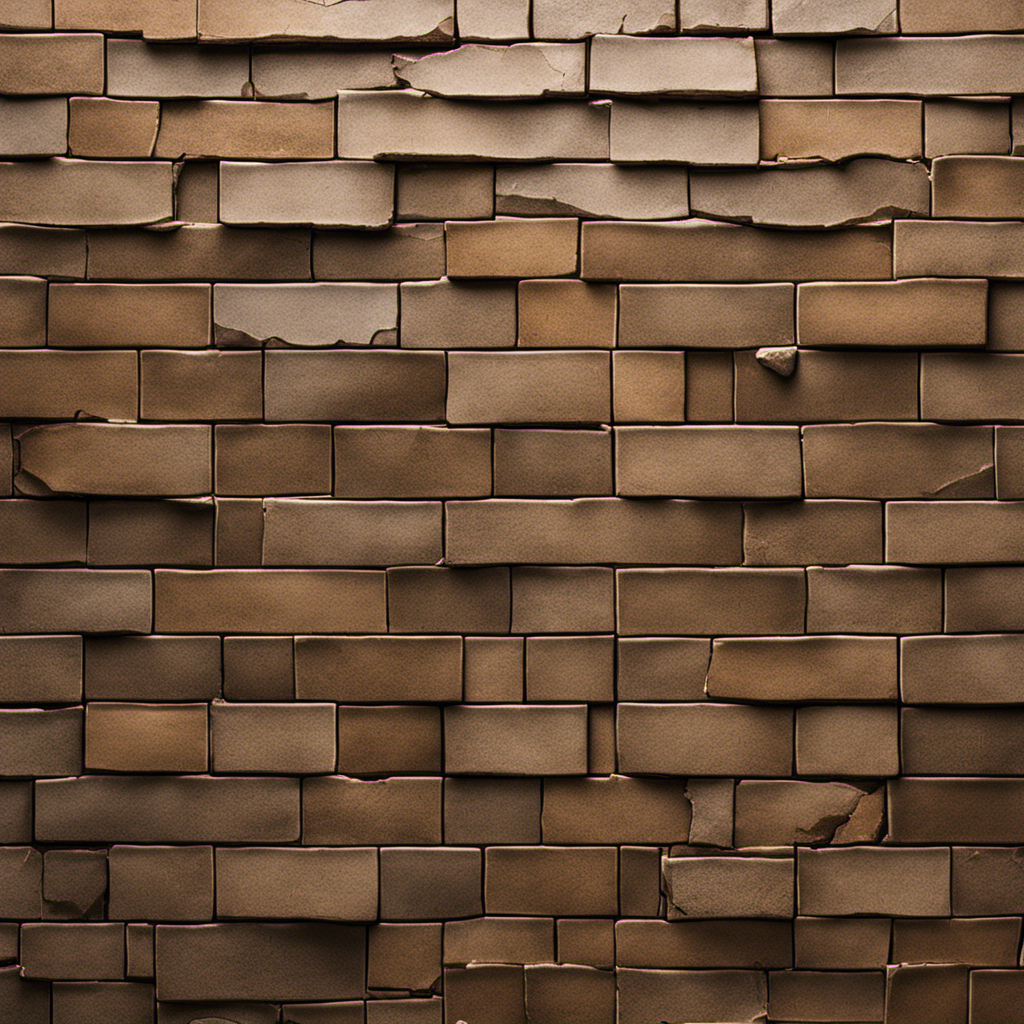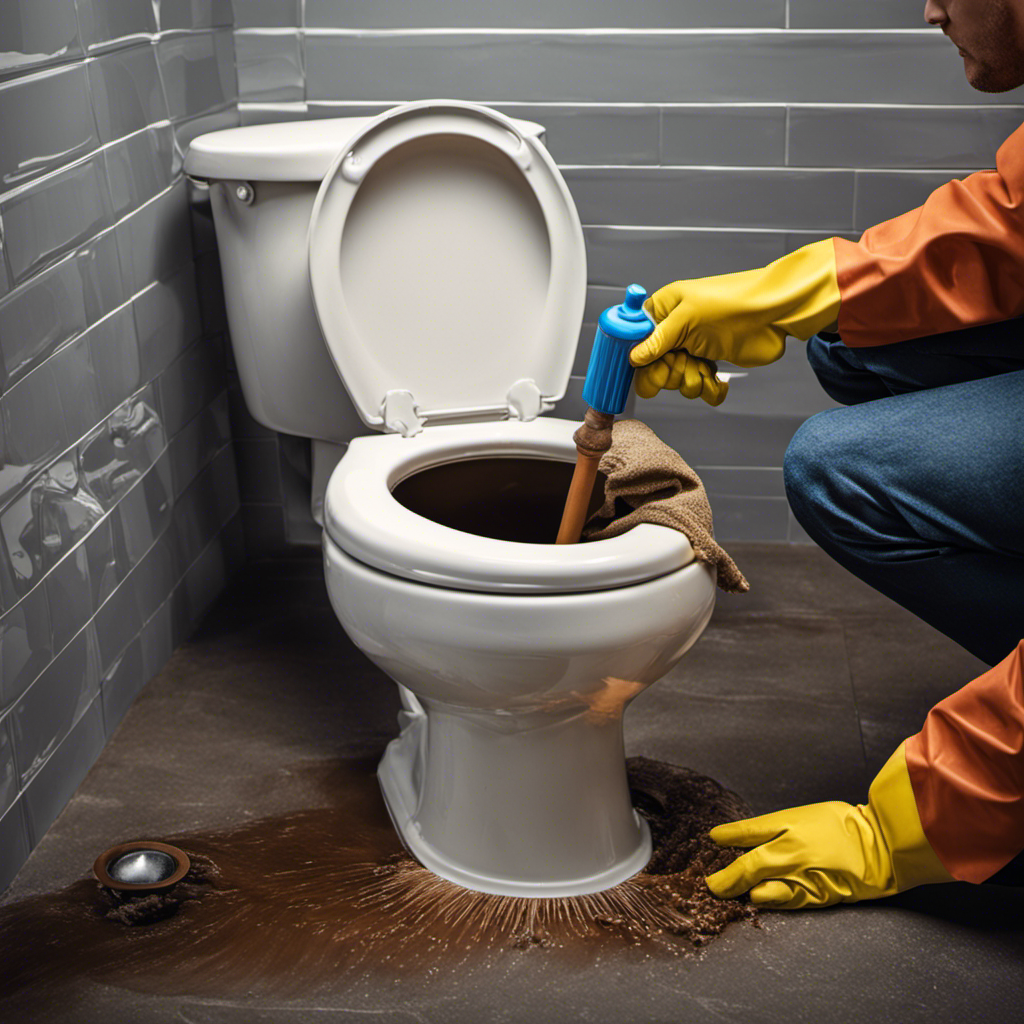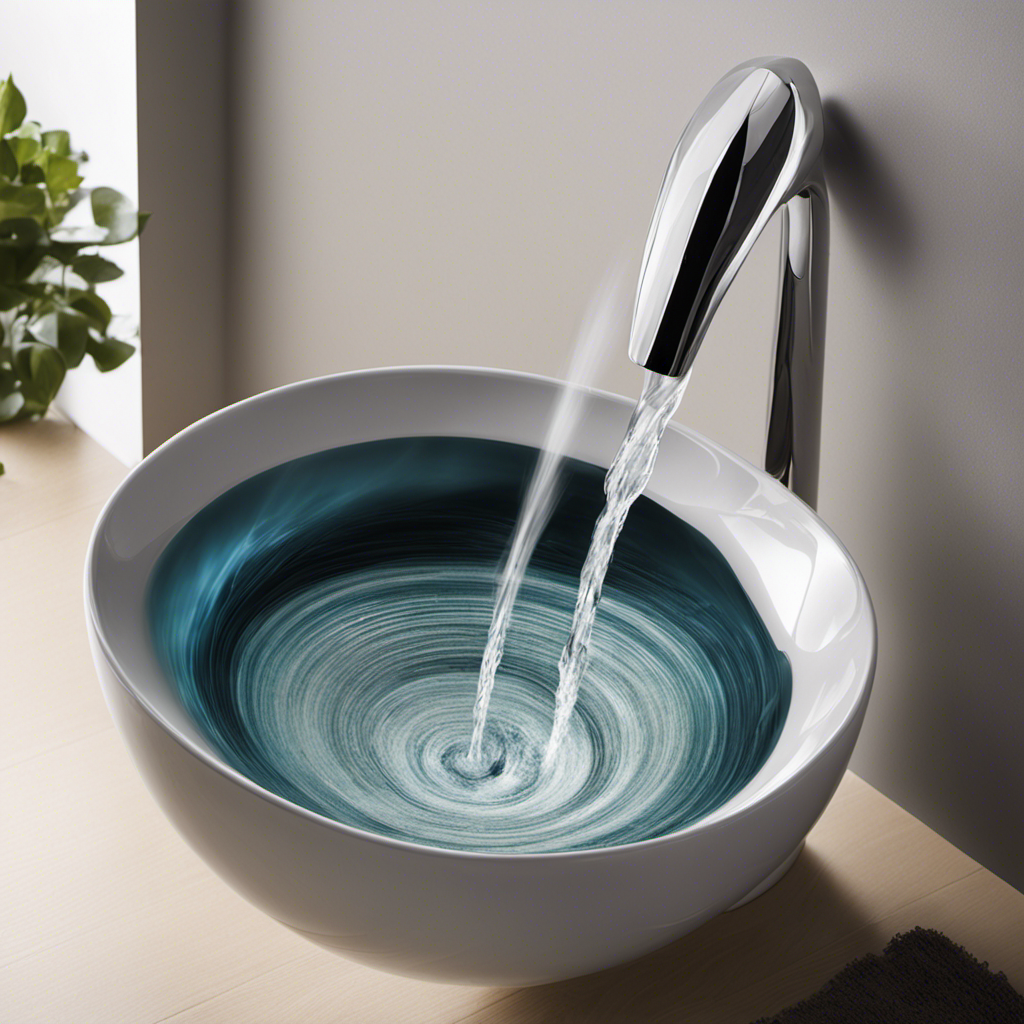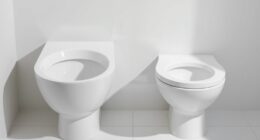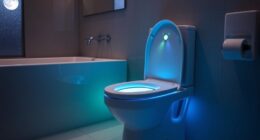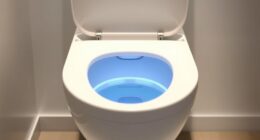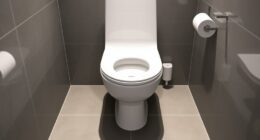As they say, ‘measure twice, install once.’ When it comes to mastering the rough-in of a toilet, accurate measurements are key for a flawless installation.
I’m here to share some key tips that will ensure your toilet is set up perfectly. From setting the toilet flange at the correct distance to ensuring proper clearance and positioning the cold water supply line, I’ll guide you through each step of the process.
Let’s dive in and make sure your toilet installation is nothing short of perfect.
Key Takeaways
- Accurate measurement of the rough-in is crucial for a successful toilet installation.
- The rough-in distance should be 12 inches from the finished wall, taking into account the thickness of stud walls.
- The minimum clearance from the toilet’s center to the sidewall should be 15 inches.
- Follow the plumbing code for required clearances between the front of the toilet and obstructions.
Understanding the Importance of Toilet Rough-In Measurements
Understanding the importance of accurate toilet rough-in measurements is crucial for ensuring a flawless installation. Proper measurement is the foundation of a successful toilet installation. To measure the rough-in accurately, follow these step-by-step instructions:
- Start by locating the center of the toilet flange.
- Measure the distance from the center of the flange to the finished wall.
- Take into account the thickness of stud walls if applicable.
- Determine the appropriate rough-in measurement for your toilet (10 inches, 12 inches, or 14 inches).
- Ensure a minimum clearance of 15 inches from the toilet’s center to the sidewall.
- Measure the required clearance between the front of the toilet and obstructions, following plumbing code guidelines.
- Locate the cold water supply line six inches to the left and seven inches above the floor.
Common Mistakes to Avoid in Toilet Rough-In Installation
I should avoid making common mistakes during the rough-in installation of a toilet. Troubleshooting common problems and ensuring proper alignment are key to a successful installation. Here are some mistakes to avoid:
| Common Mistakes to Avoid | Tips for Prevention |
|---|---|
| Incorrect rough-in measurements | Take accurate measurements of the rough-in dimensions before purchasing a toilet. |
| Improper clearance left to right | Ensure there is enough space between the toilet and adjacent walls or fixtures. |
| Insufficient space in front of the bowl | Leave enough clearance in front of the toilet for comfortable use. |
| Incorrect location of the cold water supply line | Measure from the center of the toilet flange and position the supply line accordingly. |
| Lack of attention to plumbing codes | Follow the relevant plumbing code for clearance measurements and other specifications. |
Step-by-Step Guide to Setting the Toilet Flange at the Correct Distance
Before starting the installation process, I always make sure to measure and set the toilet flange at the correct distance from the back wall. This step is crucial for a successful toilet rough-in.
One of the common mistakes that people make is not accurately measuring the rough-in distance, which can lead to installation issues and the need for a new toilet. To avoid this, I use essential tools and equipment such as a measuring tape and a level to ensure precise measurements.
Troubleshooting common mistakes in toilet rough-in installation requires attention to detail and careful measurement. By setting the toilet flange at the right distance, I can ensure proper clearance left to right and sufficient space in front of the bowl.
Incorporating these steps into my installation process guarantees a flawless toilet rough-in.
Ensuring Proper Clearance for a Seamless Toilet Installation
To ensure a seamless toilet installation, it is important to carefully measure and consider the required clearance between the front of the toilet and any obstructions. This step is crucial for ensuring proper alignment and maximizing space in the bathroom.
By accurately measuring the clearance, you can avoid any potential issues during installation, such as difficulty accessing the toilet or limited space for movement. The plumbing code typically requires a certain distance between the front of the toilet and obstructions, such as closed doors.
Choosing the Right Rough-In Measurement for Your Toilet
When choosing the right rough-in measurement for my toilet, I need to consider the distance between the wall and the middle of the toilet drainpipe. This measurement is crucial for ensuring proper installation and functionality of the toilet.
To determine the correct rough-in, I can use measuring techniques such as measuring from the finished wall to the toilet flange. The standard rough-in measurement is 12 inches, but there are also options for 10 inches or 14 inches depending on the specific toilet model.
It’s important to choose the right toilet flange position to ensure that the toilet fits properly and allows for proper clearance and functionality. By taking accurate measurements and choosing the appropriate rough-in measurement, I can ensure a successful toilet installation.
Achieving the Minimum Clearance Requirements for Toilet Installation
I can ensure that my toilet installation meets the minimum clearance requirements by measuring the distance from the front edge of the toilet to any obstructions in accordance with the plumbing code. This is crucial to avoid any potential troubleshooting issues down the line.
Here are some key points to consider when it comes to minimum clearance requirements:
- Check the plumbing code for the specific minimum clearance requirements, which are usually set at 21 inches or 24 inches.
- Measure from the front edge of the toilet to closed doors or any other obstructions to ensure compliance.
- While additional clearance can be left if desired, it’s important to consider space limitations.
- Practicality should also be taken into account, such as the ability to comfortably use the toilet with the door closed.
Factors to Consider When Determining Clearance Measurements
Considering the plumbing code requirements, accurately measuring the distance from the front edge of the toilet to any obstructions is crucial for ensuring proper clearance during the toilet installation process.
There are several factors to consider when choosing toilet rough-in measurements to achieve this proper clearance.
Firstly, you need to set the toilet flange at the right distance from the back wall, typically 12 inches.
Secondly, ensure there is enough clearance left to right, with a minimum of 15 inches from the toilet’s center to the sidewall.
Thirdly, leave sufficient space in front of the bowl to allow for comfortable use.
Lastly, consider the location of the cold water supply line, which should be six inches to the left and seven inches above the floor, avoiding the need for unnecessary trimming.
Expert Tips for Locating the Cold Water Supply Line
Accurately positioning the cold water supply line is crucial for ensuring a successful toilet installation. When it comes to locating the water line, there are expert tips that can help troubleshoot water line issues and optimize water flow. Here are some key considerations:
- Determine the center of the toilet flange as the starting point.
- Measure six inches to the left and seven inches above the floor for the cold water supply line. This positioning ensures clearance from the base molding and avoids an unsightly appearance.
- By locating the water line accurately, you can avoid the need for unnecessary trimming and ensure a seamless installation.
- Proper positioning of the water line contributes to the overall aesthetics of the toilet and enhances water flow efficiency.
The Impact of Proper Water Line Positioning on Toilet Installation
By properly positioning the water line, I can ensure a seamless installation of the toilet and optimize its performance. The impact of water pressure on toilet performance cannot be underestimated. Incorrect water line positioning can lead to problems such as weak flushes and slow refills.
To avoid these issues, it is crucial to position the water line correctly. Additionally, using a wax ring for toilet installation has numerous benefits. The wax ring creates a watertight seal between the toilet and the flange, preventing leaks and odors. It also helps to stabilize the toilet and reduce movement during use.
Furthermore, the wax ring can compensate for minor irregularities in the floor and provide a secure and long-lasting installation. Overall, proper water line positioning and the use of a wax ring are essential for ensuring optimal toilet performance and longevity.
Troubleshooting Common Issues in Toilet Rough-In Installation
When it comes to toilet rough-in installation, there are a few common issues that can arise. However, with the right troubleshooting techniques, these problems can be easily resolved.
Here are some tips to help you troubleshoot common issues in toilet rough-in installation:
-
Leaking at the base:
-
Ensure that the wax ring is properly aligned and seated on the flange.
-
Check for any cracks or damage to the toilet base that may be causing the leak.
-
Uneven or wobbly toilet:
-
Make sure that the toilet is properly leveled.
-
Use shims if necessary to stabilize the toilet and prevent any wobbling.
By addressing these common issues and following these troubleshooting techniques, you can ensure a flawless toilet rough-in installation.
Remember to take your time and double-check all measurements and connections to avoid any future problems.
Finalizing Your Flawless Toilet Rough-In: Finishing Touches and Considerations
I can now focus on the finishing touches and considerations to complete my flawless toilet rough-in.
Ensuring proper alignment is crucial for a successful installation. I will start by leveling and centering the toilet bowl. This will ensure that the weight is distributed evenly and prevent any rocking or instability.
Next, I need to select the right toilet flange. It is important to choose the appropriate material, such as PVC or cast iron, based on the specific needs of my installation. Additionally, I should consider the different installation options available, such as compression or solvent welding.
Frequently Asked Questions
Can I Install a Toilet With a Rough-In Measurement That Is Different From the Standard 12 Inches?
Yes, you can install a toilet with a rough-in measurement that is different from the standard 12 inches. However, it’s important to consider the alternatives and weigh the pros and cons of non-standard rough-in measurements.
What Should I Do if the Rough-In Measurement From My Wall to the Toilet Flange Is Less Than 12 Inches?
If my rough-in measurement is less than 12 inches, I can adjust it using offset flanges or offset toilet bolts. These alternative installation options allow for proper alignment and ensure a secure and functional toilet.
Is It Possible to Have Too Much Clearance Between the Front of the Toilet and Obstructions?
Yes, it is possible to have too much clearance between the front of the toilet and obstructions. While additional clearance can be left, space limitations may not allow for large amounts of clearance.
How Do I Determine the Location of the Cold Water Supply Line for My Toilet?
To determine the location of the cold water supply line for my toilet, I measure six inches to the left and seven inches above the floor from the center of the toilet flange.
What Are Some Common Issues That Can Arise During Toilet Rough-In Installation and How Can I Troubleshoot Them?
Common problems during toilet installation can include incorrect rough-in measurements, inadequate clearance, and improper positioning of the cold water supply line. Troubleshoot by double-checking measurements, adjusting clearance, and accurately locating the water line.
Conclusion
In conclusion, mastering the rough-in of a toilet is crucial for a flawless installation. By accurately measuring the rough-in distance and considering important factors such as clearance, flange placement, and water supply line positioning, you can ensure a seamless toilet installation.
One interesting statistic to note is that, according to plumbing experts, approximately 30% of toilet installation issues are due to incorrect rough-in measurements. Therefore, taking the time to understand and master the rough-in process is essential for a successful and hassle-free toilet installation.

